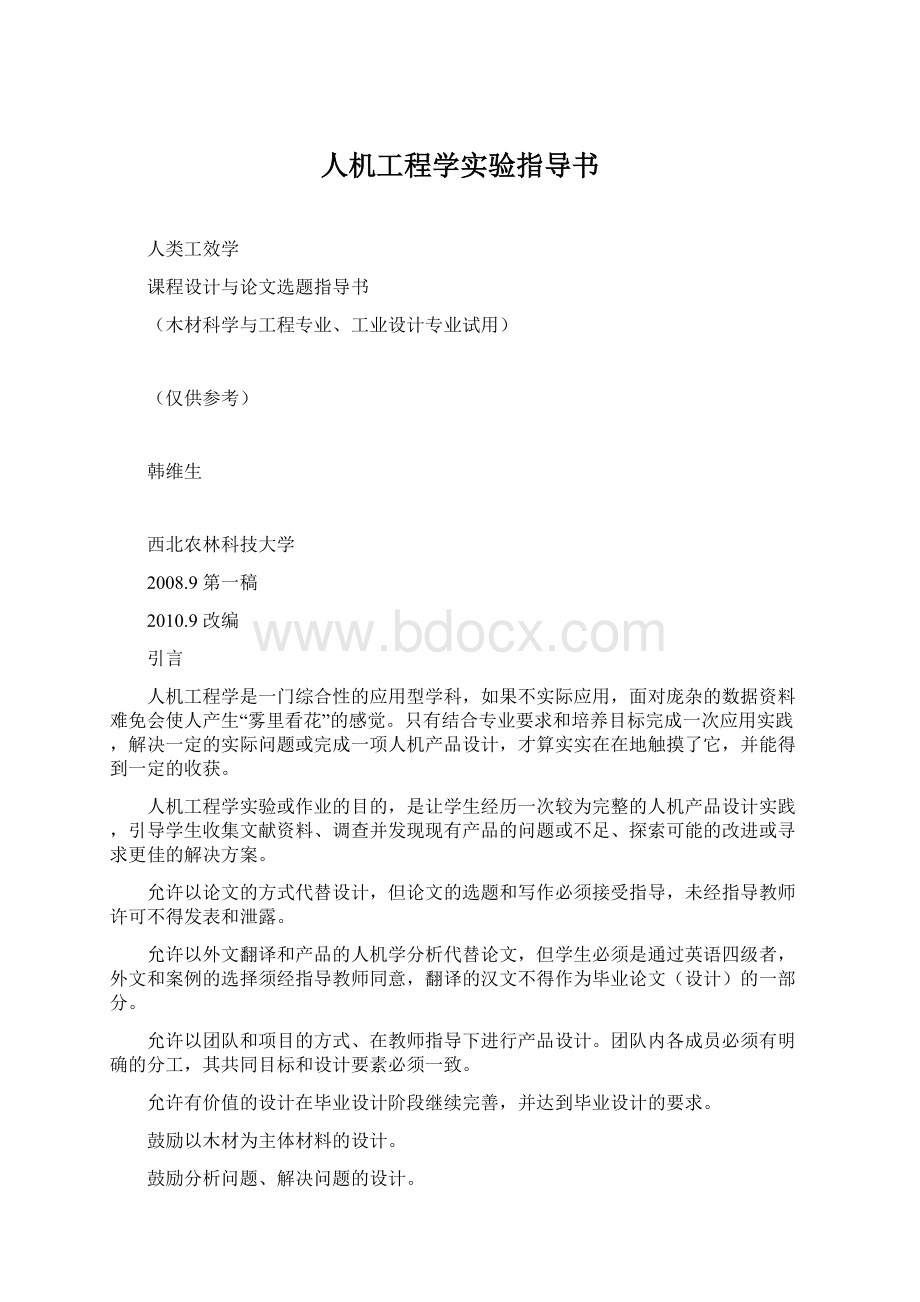人机工程学实验指导书Word下载.docx
《人机工程学实验指导书Word下载.docx》由会员分享,可在线阅读,更多相关《人机工程学实验指导书Word下载.docx(16页珍藏版)》请在冰豆网上搜索。

允许有价值的设计在毕业设计阶段继续完善,并达到毕业设计的要求。
鼓励以木材为主体材料的设计。
鼓励分析问题、解决问题的设计。
鼓励与生产实践相结合的设计或论文。
鼓励不完善但富有创新性的设计。
不同的设计有不同的评判标准,对设计过程的评判取决于师生交流的程度。
目录
总体指导…………………………………………………………………………………4
实验一工效学与家具尺寸………………………………………………………………………6
实验二应用工效学进行设计……………………………………………………………………7
总体指导
调研
解决作业所涉及的问题,仅仅依靠教材是不够的。
学生要完成作业,必须作两方面的调研:
文献资料的调研和现有产品的调研。
学生可以去图书馆、资料室、网络、一定的生活环境进行收集信息、观察调研。
对现有产品进行调研时应现场绘制草图并测量主要尺寸,以便改进设计。
通过调研,激发学生的学习主动性,培养学生自我钻研、改革创新的精神和应用人机知识分析问题、解决问题的能力。
选题
教师可以提供一定数量的作业题目供学生选择,学生也可以在征求老师意见的前提下自拟题目。
建议题目与家具设计或制造相关,但不反对其它产品的人机学设计。
学生应在一周内选定题目,中途不得更改,以免延误时间。
大部分题目应该一个人独立完成,对于工作量大的题目可由2~3人完成。
题目选定后报告给老师以便记录和跟踪辅导。
辅导
在辅导答疑过程中,教师只向学生作原则性、方向性等方面的指导,而不对具体问题作具体的回答。
鼓励多方案的设计,鼓励“为不久的将来而设计”,鼓励多学科交叉、多技术融合的设计。
过程检查
问题的核心和关键往往是开头和中间。
因此,在作业的开始和中间,教师应加强督促检查。
有关调研工作应该在课外完成,而课堂时间是教师和学生交流的时间,学生要合理地安排时间和工作进度,保证按期完成工作。
交流
有条件的情况下,同学们应该多进行交流,互相启发。
对于资料的应用,不应是照搬找抄,而应作一定的分析。
在设计的最后环节应分享成果,以便开阔眼界和思路。
总结
学生在作业的最后部分,应就设计的结论、创新点、得失、优缺点、需要进一步研究的问题进行简要总结。
作业要求和格式
作业无固定的格式和版式,建议用A4纸打印若干张彩图,不反对手绘。
作业应有设计图纸和设计说明。
图纸应尽可能表达设计意图,采用三视图或配以透视图,应标注必要的三维空间尺寸和主要零部件的主要尺寸,并说明它们与人体尺寸的关系,对零部件明细表、结构和工艺不多要求。
说明应简明扼要,包括题目、调研分析、方案构思、多方案比较、对本设计的说明(尤其是图样本身未能表达的问题)、小结,做到有理有据,最后注明参考文献和原始图片出处。
所有作业纸张应装订成册,配以封面。
答辩
为了交流,同时避免作业雷同,至少在课程结束一周内,学生应亲自将作业的打印稿交给老师,同时回答老师提出的1~2道问题。
参考题目
坐卧类
1某种椅子(如与电脑桌结合)的人机学设计
2学生床的人机学设计
桌台类
3电脑桌的人机学设计
4阅览桌的人机学设计
5绘图桌的人机学设计
6阅报桌的人机学设计
7校用实验台的人机学设计
柜类
8书柜的人机学设计
架类
9书架的人机学设计
10期刊架人机学设计
11报纸架的人机学设计
12光盘架的人机学设计
其它单一产品类
13书车的人机学设计
14书梯的人机学设计
15书踏的人机学设计
生活方式类
16为坐而设计
配套设计类
17图书馆配套家具的人机学设计
室内设计类
18本科生公寓的人机学设计
实验安排
实验一与实验二是相关的,是同一题目不同阶段的安排。
实验一工效学与家具尺寸
(实验一的内容仅指在课时内的作业内容)
1作业目的
了解并逐渐熟悉某种家具的人机尺寸。
2作业内容
1)测定某种家具的三维总体尺寸和主要局部尺寸、主要零部件的人机尺寸;
2)与人体尺寸及其计算结果进行对比,从而分析现有产品。
3方法步骤
测量法
文献资料数据分析计算法
比较法
1)根据选题,分析家具的尺寸。
2)测定家具的有关尺寸。
3)针对某尺寸,查阅相关资料及标准,进行适当的计算。
4)将理想数据与现状数据进行对比。
对比时可参考人机国家标准和家具国家标准。
5)分析现有产品。
6)提出初步的改进意见和方案。
4作业要求
1)人体尺寸的数据选用要合理。
2)计算要有依据和步骤。
为进一步的设计提供参考依据
实验二应用工效学进行设计
(实验二的内容仅指在课时内的作业内容)
通过具体的产品设计,掌握人体工程学的基本知识,培养应用工效学设计产品或环境的初步能力。
应用各种人机知识,设计一种家具,或配套家具,或应用人机知识进行特定场所的简单室内设计。
三视图、效果图
编写设计说明
1)根据选题,分析可能的主要人机问题。
不仅包括尺寸,而且包括其它方面的问题。
2)理论结合实际,应用人机知识解决问题。
3)绘制三视图。
4)简要作出设计说明。
5)完善设计文件。
按总体要求和格式。
评分准则:
1、设计说明不少于2页或3000字。
图纸包括三视图和效果图。
2、根据设计说明的详细程度、设计功能造型等的新颖性、复杂性综合定成绩。
人类工效学论文选题方向15/41
ActivityTheoriesforWorkAnalysisandDesign
(ID:
AC)
Thechallengeofactivity-drivenapproachesforchanges
Objective
InAugust2000,theInternationalErgonomicsAssociationCounciladoptedanofficialdefinition,writingthat《ergonomicsisasystems-orienteddisciplinewhichnowextendsacrossallaspectsofhumanactivity》ItwasdecidedinJuly2005,toformaTechnicalCommitteenamed《Activitytheoriesforworkanalysisanddesign》.Itsobjectivesare:
▪Todeveloparesearchcommunityinterestedbyculturalandhistoricalapproachesofhumanconductinergonomics.
▪Todocumentandtodisseminatetheoriesandmethodsbasedontheseapproachesforfieldanalysisanddesign.
▪Toorganizecollaborativeeventsforresearchersandpractitionersinterestedbythisarea.
AftertwopreviouseventsoftheTCATWAD(Maastricht,2006,andHelsinki,2008),the17thtriennialIEAcongressprovidestheopportunitytocreateauniqueforumforexchangesanddialogueswiththeChineseandAsiancommunitiesinterestedbyactivity-drivendesignapproachesforchanges.“Activityapproaches”isunderstoodinthebroadsense.CulturalandHistoricalActivityTheory,butalsosituatedapproachesofactionandcognitionatwork,orworkplacestudiesandpractice-basedapproachesarewelcome.
Themes
Submissionsareinvitedinallareasoftheoreticalandempiricalresearchinergonomics:
intervention,designandchange,well-beingandoccupationalhealth,etc.
Presentations
Nexttooralpresentations,posters,roundtablediscussionsmaybeproposed.Theproposalwilleitherfocusontheoreticalandempiricalresearchorintervention.PresentationswillbepublishedintheproceedingsoftheIEA2009Congress.
SubmissionandImportantdates
AbstractscanbesubmittedattheIEACongresswebsite(www.iea2009.org).
PleasemakesuretoselecttheTrackIDasakeywordwhensubmittingyourpaper.
Submissionof500wordabstract:
November15,2008.
Notificationofacceptance:
January1,2009.
Fullpaper:
April1,2009.
AffectiveDesign(ID:
AF)
TheAffectiveProductDesign(AF)TrackisacceptingsubmissionsfortheAFTrackattheIEA2009CongressinBeijing,China.Thistrackencouragessymposia,panels,anddemonstrationsthataddressaffective/emotionaldesignandevaluationofproducts.Thecontentcouldincludelaboratory,fieldandcasestudies,conceptualmodels,anddemonstrations.Relevanttopicsincludenovelmethodsformeasurementofaffect,cross-culturalandusabilityissuesinaffectivedesign,developmentofaffectivedesignstandards.SymposiawithpapersthatcombineAffectiveDesignmethodswithparticulardomainareas(e.g.healthcare,transportation,buildingandconstruction)areespeciallywelcomed.Wearealsointerestedindemonstrationsofnewproducts/tools/software/methodsthataddressaffectiveissuesforyoungandelderlyusers.
Aging(ID:
AG)
TheIEAAgingTechnicalCommitteeisacceptingsubmissionsfortheAgingTrackattheIEA2009CongressinBeijing,China.AgingTrackencouragessymposia,panels,anddemonstrationsthataddressforexampleAgingandwork,PromotionofWorkability,HealthandWellbeingofAgingworkers,FemaleworkersandAging,Agemanagement,Gerotechnology,Agingworkersandtechnology,Agingandworkinghours,Agingandlearning.
Thecontentcouldincludelaboratory,fieldandcasestudies,conceptualmodels,anddemonstrations.Symposiawithpapersthatcombineagingwithparticulardomainareas(e.g.healthcare,transportation,buildingandconstruction)areespeciallywelcomed.Wearealsointerestedindemonstrationsofnewproducts/tools/software/methodsthataddressaffectiveissuesforelderlyusers.
AgriculturalErgonomics(ID:
AR)
TheIEAAgricultureErgonomicsTrack(formerlythePrimaryIndustriesTechnicalCommittee)isnowacceptingsubmissionsfortheIEA2009CongressinBeijing,China.ThisTrackcallsforproposalsforsymposia,panels,workshops,fielddemonstrationsandpapersthataddresscurrentoremergingissuesinagriculture,horticulture,forestry,viticultureandanyotherland-basedindustries.Inparticularweareinterestedinproposalsrelatedtoanyofthefollowingtopics:
•
Ergonomicapplicationsinproductionagriculture
Ergonomicapplicationsinlabor-intensiveagriculture
Agriculturalmachineryandequipmentdesignandsafety
Newtechnologiesinagriculture
Agriculturalhealthandsafety
Specialpopulationsinagriculture:
youths,elderly,migrantandseasonalworkers,etc.
Theinterestofthistrackalsocoverotherpredominantlyruraloccupationsincludingfishingandthetransportationandprimaryprocessingofproduce–forexamplelogtruckdriving,initialseafoodprocessingandsawmillwork.
Thecontentoftheseofferingscouldincludecasestudies,reportsoflaboratoryresearch,anddescriptionsoffieldmethods,conceptualmodels,evaluations,implementationapproachesandinterventionprogrammedesign.Demonstrationsorexamplesofnewproducts/tools/software/methodsthathavehadimpactinaddressingcommonergonomicsproblemsorlivelihoodissuesintheseindustrieswouldalsobeverywelcome.
Inparticular,wearelookingforcontributionscoveringnovelmethodsofqualitativeandquantitativedatacollectioninthefield,andalsoanypresentationsthatdiscussmethodsforthereliableevaluationofinterventioneffectivenessinruralcommunities.
ChildrenandSchoolErgonomics(ID:
CH)
Papersonallaspectsofergonomicsforchildren,youthsandstudentsareencouragedtobepartoftheChildrenandSchoolErgonomicsTrackorganizedbytheIEATechnicalCommitteeonErgonomicsforChildrenandEducationalEnvironments(ECEE).Suggestedscopeoftopicsmightinclude:
backpacks,furniture&
equipment,productdevelopment,technologyuse,andeducation.Paneldiscussionsandjointpresentationswithmembersofothertracksarewelcome.
Developmentofpracticesandworkchanges
EW)
Intheworkenvironment,formalandinformaltrainingplaysanessentialroleasameansofcontributingtoandsupportingmanytechnicalandorganisationalchanges.Whiletrainingprogrammesareoftendesignedforoperatorstoadapt,thestudiesbasedontheergonomicanalysisofworkhaveshowntheycanhaveanotherstatusallowingactorsthemselvesto“appropriate”changesbymakingthelearningactivityandworkthemainfocusofthetraining,andreiteratingtherelevanceoftreatingtheissueofwell-beingalongwiththeeconomicandmanagementconsiderations.
Howdochangesintheformofemployment(developmentofprecariousjobs,oratypicalworkinghours),organisationofwork(combinedindustrialandtradeconstraints),technologies(increasinguseofnewtechnologiesofcommunicationandinformation)transformthepracticeoftrainingfromtheviewpointofthetrainingstaff,butalsoforergonomistsandthewaytheyviewthefieldoftraining?
Howhaveresearchandpracticalexercisesbasedontheergonomicanalysesofwork,contributedtotransformworkthroughtrainingorgivecluestoth